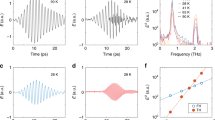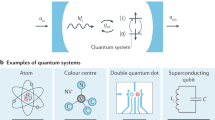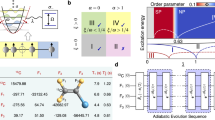Abstract
In conventional Bardeen–Cooper–Schrieffer superconductors1, electrons with opposite momenta bind into Cooper pairs due to an attractive interaction mediated by phonons in the material. Although superconductivity naturally emerges at thermal equilibrium, it can also emerge out of equilibrium when the system parameters are abruptly changed2,3,4,5,6,7,8. The resulting out-of-equilibrium phases are predicted to occur in real materials and ultracold fermionic atoms, but not all have yet been directly observed. Here we realize an alternative way to generate the proposed dynamical phases using cavity quantum electrodynamics (QED). Our system encodes the presence or absence of a Cooper pair in a long-lived electronic transition in 88Sr atoms coupled to an optical cavity and represents interactions between electrons as photon-mediated interactions through the cavity9,10. To fully explore the phase diagram, we manipulate the ratio between the single-particle dispersion and the interactions after a quench and perform real-time tracking of the subsequent dynamics of the superconducting order parameter using nondestructive measurements. We observe regimes in which the order parameter decays to zero (phase I)3,4, assumes a non-equilibrium steady-state value (phase II)2,3 or exhibits persistent oscillations (phase III)2,3. This opens up exciting prospects for quantum simulation, including the potential to engineer unconventional superconductors and to probe beyond mean-field effects like the spectral form factor11,12, and for increasing the coherence time for quantum sensing.
This is a preview of subscription content, access via your institution
Access options
Access Nature and 54 other Nature Portfolio journals
Get Nature+, our best-value online-access subscription
$29.99 / 30 days
cancel any time
Subscribe to this journal
Receive 51 print issues and online access
$199.00 per year
only $3.90 per issue
Buy this article
- Purchase on Springer Link
- Instant access to full article PDF
Prices may be subject to local taxes which are calculated during checkout




Similar content being viewed by others
Data availability
The datasets generated for this study are available in a Dryad repository with the identifier https://doi.org/10.5061/dryad.7h44j100j (ref. 55).
References
Bardeen, J., Cooper, L. N. & Schrieffer, J. R. Theory of superconductivity. Phys. Rev. 108, 1175 (1957).
Yuzbashyan, E. A., Tsyplyatyev, O. & Altshuler, B. L. Relaxation and persistent oscillations of the order parameter in fermionic condensates. Phys. Rev. Lett. 96, 097005 (2006).
Barankov, R. A. & Levitov, L. S. Synchronization in the BCS pairing dynamics as a critical phenomenon. Phys. Rev. Lett. 96, 230403 (2006).
Yuzbashyan, E. A. & Dzero, M. Dynamical vanishing of the order parameter in a fermionic condensate. Phys. Rev. Lett. 96, 230404 (2006).
Gurarie, V. & Radzihovsky, L. Resonantly paired fermionic superfluids. Ann. Phys. 322, 2–119 (2007).
Gurarie, V. Nonequilibrium dynamics of weakly and strongly paired superconductors. Phys. Rev. Lett. 103, 075301 (2009).
Foster, M. S., Dzero, M., Gurarie, V. & Yuzbashyan, E. A. Quantum quench in a p + ip superfluid: winding numbers and topological states far from equilibrium. Phys. Rev. B 88, 104511 (2013).
Yuzbashyan, E. A., Dzero, M., Gurarie, V. & Foster, M. S. Quantum quench phase diagrams of an s-wave BCS-BEC condensate. Phys. Rev. A 91, 033628 (2015).
Lewis-Swan, R. J. et al. Cavity-QED quantum simulator of dynamical phases of a Bardeen–Cooper–Schrieffer superconductor. Phys. Rev. Lett. 126, 173601 (2021).
Kelly, S. P., Thompson, J. K., Rey, A. M. & Marino, J. Resonant light enhances phase coherence in a cavity QED simulator of fermionic superfluidity. Phys. Rev. Res. 4, L042032 (2022).
Stewart, G. R. Unconventional superconductivity. Adv. Phys. 66, 75–196 (2017).
Sato, M. & Ando, Y. Topological superconductors: a review. Rep. Prog. Phys. 80, 076501 (2017).
Zhou, X. et al. High-temperature superconductivity. Nat. Rev. Phys. 3, 462–465 (2021).
Shuryak, E. Strongly coupled quark-gluon plasma in heavy ion collisions. Rev. Mod. Phys. 89, 035001 (2017).
Harlow, D. Jerusalem lectures on black holes and quantum information. Rev. Mod. Phys. 88, 015002 (2016).
Marino, J., Eckstein, M., Foster, M. & Rey, A.-M. Dynamical phase transitions in the collisionless pre-thermal states of isolated quantum systems: theory and experiments. Rep. Prog. Phys. 85, 116001 (2022).
Volkov, A. F. & Kogan, S. M. Collisionless relaxation of the energy gap in superconductors. J. Exp. Theor. Phys. 38, 1018 (1974). [Russian original—Zh. Eksp. Teor. Fiz. 65, 2038 (1973)].
Yuzbashyan, E. A., Altshuler, B. L., Kuznetsov, V. B. & Enolskii, V. Z. Solution for the dynamics of the BCS and central spin problems. J. Phys.: Math. Gen. 38, 7831 (2005).
Barankov, R. A., Levitov, L. S. & Spivak, B. Z. Collective Rabi oscillations and solitons in a time-dependent BCS pairing problem. Phys. Rev. Lett. 93, 160401 (2004).
Yuzbashyan, E. A. Normal and anomalous solitons in the theory of dynamical Cooper pairing. Phys. Rev. B 78, 184507 (2008).
Foster, M. S., Gurarie, V., Dzero, M. & Yuzbashyan, E. A. Quench-induced Floquet topological p-wave superfluids. Phys. Rev. Lett. 113, 076403 (2014).
Collado, H. P. O., Defenu, N. & Lorenzana, J. Engineering Higgs dynamics by spectral singularities. Phys. Rev. Res. 5, 023011 (2023).
Mansart, B. et al. Coupling of a high-energy excitation to superconducting quasiparticles in a cuprate from coherent charge fluctuation spectroscopy. Proc. Natl Acad. Sci. USA 110, 4539–4544 (2013).
Matsunaga, R. et al. Higgs amplitude mode in the BCS superconductors Nb1−xTixN induced by terahertz pulse excitation. Phys. Rev. Lett. 111, 057002 (2013).
Matsunaga, R. et al. Light-induced collective pseudospin precession resonating with Higgs mode in a superconductor. Science 345, 1145–1149 (2014).
Randeria, M. & Taylor, E. BCS-BEC crossover and the unitary Fermi gas. Annu. Rev. Condens. Matter Phys. 5, 209–232 (2014).
Behrle, A. et al. Higgs mode in a strongly interacting fermionic superfluid. Nat. Phys. 14, 781–785 (2018).
Anderson, P. W. Random-phase approximation in the theory of superconductivity. Phys. Rev. 112, 1900 (1958).
Davis, E. J. et al. Protecting spin coherence in a tunable Heisenberg model. Phys. Rev. Lett. 125, 060402 (2020).
Norcia, M. A. et al. Cavity-mediated collective spin-exchange interactions in a strontium superradiant laser. Science 361, 259–262 (2018).
Allred, J. C., Lyman, R. N., Kornack, T. W. & Romalis, M. V. High-sensitivity atomic magnetometer unaffected by spin-exchange relaxation. Phys. Rev. Lett. 89, 130801 (2002).
Kleine, A., Kollath, C., McCulloch, I. P., Giamarchi, T. & Schollwoeck, U. Excitations in two-component Bose gases. New J. Phys. 10, 045025 (2008).
Deutsch, C. et al. Spin self-rephasing and very long coherence times in a trapped atomic ensemble. Phys. Rev. Lett. 105, 020401 (2010).
Smale, S. et al. Observation of a transition between dynamical phases in a quantum degenerate Fermi gas. Sci. Adv. 5, eaax1568 (2019).
Muniz, J. A. et al. Exploring dynamical phase transitions with cold atoms in an optical cavity. Nature 580, 602–607 (2020).
Baghdad, M. et al. Spectral engineering of cavity-protected polaritons in an atomic ensemble. Nat. Phys. 19, 1104–1109 (2023).
Sauerwein, N. et al. Engineering random spin models with atoms in a high-finesse cavity. Nat. Phys. 19, 1128–1134 (2023).
Richardson, R. & Sherman, N. Exact eigenstates of the pairing-force Hamiltonian. Nucl. Phys. 52, 221–238 (1964).
Gaudin, M. Diagonalization of a class of spin Hamiltonians. J. Phys. 37, 1087–1098 (1976).
Weiner, J. M., Cox, K. C., Bohnet, J. G., Chen, Z. & Thompson, J. K. Superradiant Raman laser magnetometer. Appl. Phys. Lett. 101, 261107 (2012).
Bohnet, J. G., Chen, Z., Weiner, J. M., Cox, K. C. & Thompson, J. K. Active and passive sensing of collective atomic coherence in a superradiant laser. Phys. Rev. A 88, 013826 (2013).
Norcia, M. A., Winchester, M. N., Cline, J. R. & Thompson, J. K. Superradiance on the millihertz linewidth strontium clock transition. Sci. Adv. 2, e1601231 (2016).
Rey, A. M., Jiang, L., Fleischhauer, M., Demler, E. & Lukin, M. D. Many-body protected entanglement generation in interacting spin systems. Phys. Rev. A 77, 052305 (2008).
Black-Schaffer, A. M. Edge properties and Majorana fermions in the proposed chiral d-wave superconducting state of doped graphene. Phys. Rev. Lett. 109, 197001 (2012).
Nandkishore, R., Levitov, L. S. & Chubukov, A. V. Chiral superconductivity from repulsive interactions in doped graphene. Nat. Phys. 8, 158–163 (2012).
Kiesel, M. L., Platt, C., Hanke, W., Abanin, D. A. & Thomale, R. Competing many-body instabilities and unconventional superconductivity in graphene. Phys. Rev. B 86, 020507 (2012).
Kiesel, M. L., Platt, C., Hanke, W. & Thomale, R. Model evidence of an anisotropic chiral d + id-wave pairing state for the water-intercalated NaxCoO2 ⋅ yH2O superconductor. Phys. Rev. Lett. 111, 097001 (2013).
Fischer, M. H. et al. Chiral d-wave superconductivity in SrPtAs. Phys. Rev. B 89, 020509 (2014).
Shankar, A. et al. Simulating dynamical phases of chiral p + ip superconductors with a trapped ion magnet. PRX Quantum 3, 040324 (2022).
Laughlin, R. Magnetic induction of \({d}_{{x}^{2}-{y}^{2}}+i{d}_{xy}\) order in high-Tc superconductors. Phys. Rev. Lett. 80, 5188 (1998).
Balatsky, A. V., Vekhter, I. & Zhu, J.-X. Impurity-induced states in conventional and unconventional superconductors. Rev. Mod. Phys. 78, 373 (2006).
Schäfer, T. & Teaney, D. Nearly perfect fluidity: from cold atomic gases to hot quark gluon plasmas. Rep. Prog. Phys. 72, 126001 (2009).
Pehlivan, Y., Balantekin, A., Kajino, T. & Yoshida, T. Invariants of collective neutrino oscillations. Phys. Rev. D 84, 065008 (2011).
Norcia, M. A. et al. Frequency measurements of superradiance from the strontium clock transition. Phys. Rev. X 8, 021036 (2018).
Young, D. J. et al. Data for: observing dynamical phases of BCS superconductors in a cavity QED simulator. Dryad https://doi.org/10.5061/dryad.7h44j100j (2023).
Acknowledgements
This material is based upon work supported by the US Department of Energy, Office of Science, National Quantum Information Science Research Centers, Quantum Systems Accelerator. We acknowledge additional funding support from the National Science Foundation under Grant Nos. 2317149 (Physics Frontier Center) and OMA-2016244 (Quantum Leap Challenge Institutes), the National Institute of Standards and Technology, the Army Research Office of the Defense Advanced Research Projects Agency (Grant Nos. W911NF-19-1-0210 and W911NF-16-1-0576) and the Air Force Office of Scientific Research (Grant Nos. FA9550-18-1-0319 and FA9550-19-1-0275). We acknowledge helpful discussions with E. Yuzbashyan, V. Gurarie and A. Kaufman.
Author information
Authors and Affiliations
Contributions
D.J.Y., E.Y.S., Z.N., V.M.S. and J.K.T. collected and analysed the experimental data. A.C., D.B., D.W., R.J.L.-S. and A.M.R. developed the theoretical model. All authors discussed the results and contributed to the preparation of the manuscript.
Corresponding authors
Ethics declarations
Competing interests
The authors declare no competing interests.
Peer review
Peer review information
Nature thanks José Lorenzana, Emil Yuzbashyan and the other, anonymous, reviewer(s) for their contribution to the peer review of this work.
Additional information
Publisher’s note Springer Nature remains neutral with regard to jurisdictional claims in published maps and institutional affiliations.
Extended data figures and tables
Extended Data Fig. 1 Experimental configuration.
a, Detailed diagram of the cavity and all relevant beams. A magnetic field along \(\widehat{y}\) sets the quantization axis. The 813 nm optical lattice supported by the cavity has a tunable linear polarization. We drive a π/2 pulse with a beam polarized along \(\widehat{y}\) through the cavity, and during the experiment we probe the cavity resonance frequency using a second \(\widehat{y}\)-polarized beam to measure atom number. A 461 nm beam far-detuned from the \({|}^{1}{S}_{0}\rangle \to {|}^{1}{P}_{1}\rangle \) transition shines on the atoms from the side of the cavity, inducing a.c. Stark shifts. We probe signals transmitted through the cavity using a balanced heterodyne detector. b, Fluorescence image of the two atomic clouds used when scanning through phase III in Figs. 3 and 4. c, Frequency landscape of 689 nm beams. The atomic drive frequency ωdrive is resonant with the atomic transition. The cavity probe frequency ωcp is nominally centred with the cavity resonance frequency, 51 MHz red-detuned from the atomic transition. The local oscillator used in heterodyne detection has frequency ωLO and is 80 MHz blue-detuned from the atomic transition.
Extended Data Fig. 2 Numerical simulation of the dynamical phase diagram based on equation (3).
We identify the dynamical phases based on the long-time average (a) and the long-time standard deviation (b) of ∣ΔBCS(t)∣, normalized by its initial value Δinit ≡ ∣ΔBCS(0)∣. The white solid lines mark the corresponding dynamical phase boundaries, analytically derived from equation (1), which agree with the numerical results based on equation (3). The white dashed lines mark an extra dynamical phase transition that only exists for equation (1).
Extended Data Fig. 3 Alternative approach for phase III.
a, Simulation of an alternative experimental sequence. As described by the timing sequence at the top, we simulate an experiment that prepares the initial state using a π/2 pulse, lets the system evolve under a bimodal distribution of single-particle energy (see the inset) until ∣ΔBCS∣ reaches its minimum value and then quenches the system back to a continuous distribution of single-particle energies (inset). The theoretically predicted time trace of ∣ΔBCS∣ with χN/EW = 1.0 and δs,init/EW = 1.6 is shown at the bottom. The blue (grey dashed) line shows phase III dynamics under a continuous (bimodal) distribution. b, Long-time standard deviation of ∣ΔBCS(t)∣ after quenching to the continuous distribution shown in a. The white lines are dynamical phase boundaries for bimodal distributions (see Extended Data Fig. 2). Nearly all choices of parameters for phase III using bimodal distributions can lead to phase III behaviour after quenching to the continuous distribution.
Extended Data Fig. 4 Collective scaling in damped phase II oscillations.
a, Time dynamics of ∣ΔBCS∣ measured after engineering an initial phase spread over [0, φ0] where φ0 = 0.8π as in Fig. 2d, plotted in absolute frequency units (pink trace). The solid black curve represents a numerical simulation of the full system, whereas the dashed curve represents an ideal simulation neglecting dissipation and motional effects. We obtain a crude estimate of oscillation frequency in the experimental data by fitting a trough and peak to smoothed data (after subtracting slow-moving behaviour) within the first couple μs (magenta points), using these points to infer a half period of oscillation, and with uncertainties determined using a 90% amplitude threshold (pink bands). b, Comparing oscillation frequency estimates of experimental data (pink squares) with those of ideal simulations (black dots) for different φ0. Theory oscillation frequencies are calculated using a Fourier transform from t = 0 μs to t = 5 μs. Error bars for experimental data are set by the minimum and maximum frequencies implied by uncertainties in the half period shown in a. The two frequency estimates agree within error bars. c, Collective scaling of oscillation frequency. For each φ0 measured in the experiment, we plot the oscillation frequency against the long-time BCS gap Δ∞, calculated at t = 18 μs for ideal simulations and at t = 3 μs for experimental data. The solid black line is defined by ωosc = 2Δ∞, demonstrating the expected scaling for Higgs oscillations. The dashed pink line represents a linear fit to the experimental data. The pink band shows the uncertainty in the slope assuming correlated error in ωosc, such that its bounds are defined by linear fits to the data assuming maximum and minimum values for ωosc as defined by the error bars.
Supplementary information
Supplementary Information
Supplementary Information sections 1–3, including Figs. 1–5 and Table 1.
Rights and permissions
About this article
Cite this article
Young, D.J., Chu, A., Song, E.Y. et al. Observing dynamical phases of BCS superconductors in a cavity QED simulator. Nature 625, 679–684 (2024). https://doi.org/10.1038/s41586-023-06911-x
Received:
Accepted:
Published:
Issue Date:
DOI: https://doi.org/10.1038/s41586-023-06911-x
Comments
By submitting a comment you agree to abide by our Terms and Community Guidelines. If you find something abusive or that does not comply with our terms or guidelines please flag it as inappropriate.



